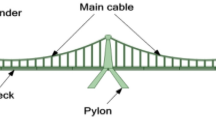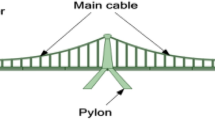Abstract
A new type of suspension bridge is proposed based on the gravity stiffness principle. Compared with a conventional suspension bridge, the proposed bridge adds rigid webs and cross braces. The rigid webs connect the main cable and main girder to form a truss that can improve the bending stiffness of the bridge. The cross braces connect the main cables to form a closed space truss structure that can improve the torsional stiffness of the bridge. The rigid webs and cross braces are installed after the construction of a conventional suspension bridge is completed to resist different loads with different structural forms. A new type of railway suspension bridge with a span of 340 m and a highway suspension bridge with a span of 1020 m were designed and analysed using the finite element method. The stress, deflection of the girders, unbalanced forces of the main towers, and natural frequencies were compared with those of conventional suspension bridges. A stiffness test was carried out on the new type of suspension bridge with a small span, and the results were compared with those for a conventional bridge. The results showed that the new suspension bridge had a better performance than the conventional suspension bridge.
Similar content being viewed by others
References
Ren W X, Harik I E, Blandford G E, Lenett M, Baseheart T M. Roebling suspension bridge. II: Ambient testing and live-load response. Journal of Bridge Engineering, 2004, 9(2): 119–126
Ge Y J. Bridge engineering: Science, technology and engineering. China Civil Engineering Journal, 2019, 52(8): 1–5 (in Chinese)
Zhou S Z. State-of-the-art of suspension bridges in China. Bridge Construction, 2003, 5: 30–34 (in Chinese)
Miyata T, Yamaguchi K. Aerodynamics of wind effects on the Akashi Kaikyo Bridge. Journal of Wind Engineering and Industrial Aerodynamics, 1993, 48(2–3): 287–315
Gülka P, Caner A, Apaydin N M. Developments in International Bridge Engineering: Selected Papers from Istanbul Bridge Conference. Cham: Springer Nature Switzerland AG, 2018, 19
Diana G, Fiammenghi G, Belloli M, Rocchi D. Wind tunnel tests and numerical approach for long span bridges: the Messina bridge. Journal of Wind Engineering and Industrial Aerodynamics, 2013, 122: 38–49
Yan J K, Peng T B, Li J Z. Shake table test of Taizhou Changjiang Highway Bridge: Test design and result analysis of seismic structural system. Journal of Southwest University (Natural Science Edition), 2014, 44(2): 357–362 (in Chinese)
Dai X R, Wang L, Wang C J, Wang X Y, Shen Y L. Anti-slip scheme of full-vertical friction plate for multi-pylon suspension bridge. Journal of Zhejiang University, 2019, 53(9): 1697–1703 (in Chinese)
Wang H, Yang M, Tao T Y, Li A Q. Parameter sensitivity analysis on dynamic characteristics of long-span quadruple-tower suspension bridge. Journal of Southwest University (Natural Science Edition), 2016, 46(3): 559–564 (in Chinese)
Tang H Q, Xu G Y, Liu H S. Feasibility analysis of suspension bridge type to railway bridges. Bridge Construction, 2017, 47(2): 13–18 (in Chinese)
Capsoni A, Ardito R, Guerrieri A. Stability of dynamic response of suspension bridges. Journal of Sound and Vibration, 2004, 393: 285–307
Zhai W M, Wang S L. Influence of bridge structure stiffness on dynamic performance of high-speed train-track-bridge coupled system. China Railway Science, 2012, 33(1): 19–26 (in Chinese)
Cantero D, McGetrick P, Kim C, OBrien E. Experimental monitoring of bridge frequency evolution during the passage of vehicles with different suspension properties. Engineering Structures, 2019, 187: 209–219
Zhang X, Du B, Xiang T Y. Parameter sensitivity analysis of dynamic characteristics of long-span road-rail suspension bridge. Railway Standard Design, 2018, 6: 77–82 (in Chinese)
Zhang W M, Liu Z, Xu S. Jindong bridge: Suspension bridge with steel truss girder and prefabricated RC deck slabs in China. Structural Engineering International, 2019, 29(2): 315–318
Feng C B. Control techniques for the superstructure construction of Wufengshan Changjiang River Bridge. Bridge Construction, 2020, 50(1): 99–103 (in Chinese)
Wang C J, Wang L, Ye Y Q, Bai Y D. Test study of anti-slip scheme of horizontal friction plates for middle tower saddle of multi-tower suspension bridge. Bridge Construction, 2020, 48(2): 13–18 (in Chinese)
Shen R L, Hou K, Wang L. Requirements of vertical stiffness and anti-slip safety for three-pylon suspension bridge. Journal of Southwest University (Natural Science Edition), 2019, 49(3): 474–480 (in Chinese)
Cao H, Qian X, Zhou Y, Chen Z, Zhu H P. Feasible range for midtower lateral stiffness in three-tower suspension bridge. Journal of Bridge Engineering, 2018, 23(3): 06017009
Chai S, Xiao R, Li X. Longitudinal restraint of a double-cable suspension bridge. Journal of Bridge Engineering, 2014, 19(4): 06013002
Wang X, Chai S, Xu Y. Sliding resistance of main cables in double-cable multispan suspension bridges. Journal of Bridge Engineering, 2017, 22(3): 06016011
Zhang X J, Ying L D. A summary of wind-resistant measures of long span suspension bridges. Highway, 2006, 11: 73–80 (in Chinese)
Andersen M S, Johansson J, Brandt A, Hansen S O. Aerodynamic stability of long span suspension bridges with low torsional natural frequencies. Engineering Structures, 2016, 120: 82–91
Arioli G, Gazzola F. Torsional instability in suspension bridges: The Tacoma Narrows Bridge case. Communications in Nonlinear Science and Numerical Simulation, 2017, 42: 342–357
Li C J, Li Y L, Tang M L, Qiang S Z. Improvement of flutter stability of long span suspension bridge with CFRP cable by crossed hangers. China Civil Engineering Journal, 2017, 3: 83–90 (in Chinese)
Qi D C, Wang H X. Model test of main cable torsion of spatial cable suspension bridge. Railway Engineering, 2016(2): 14–17 (in Chinese)
Zhang X J, Shun B N, Chen A R, Xiang H F. Flutter stability of cable-stayed-suspension hybrid bridges. China Civil Engineering Journal, 2004, 7: 106–110 (in Chinese)
de Ville de Goyet V, Duchêne Y, Propson A. 16.08: The dynamic behaviour of the third Bosporus Bridge. Special Issue: Proceedings of Eurosteel 2017, 2017, 1(2–3): 4098–4107
Barbaros A, Tayfun D, Maksym G. Optimization of cables size and prestressing force for a single pylon cable-stayed bridge with Jaya algorithm. Steel and Composite Structures, 2020, 34(6): 853–862
Xiang H F, Ge Y J. Modern theory for wind resistant bridge and its application. Mechanical Engineering (New York), 2007, 1: 1–13
Liu Z W, Xie P R, Chen Z Q, Xu G P, Xu J. Aerodynamic optimization of flutter stability of long-span streamlined box girder suspension bridge. Journal of Hunan University, 2019, 3: 1–9 (in Chinese)
Liu J, Liao H L, Li M S, Mei H Y. Effect of stabilizer on flutter stability of truss girder suspension bridges. Journal of Vibroengineering, 2017, 19(3): 1915–1929
Abdel-Rohman M, John M J. Control of wind-induced nonlinear oscillations in suspension bridges using a semi-active tuned mass damper. Journal of Vibration and Control, 2006, 12(10): 1049–1080
Guo Z W, Ge Y J, Zhao L, Li K. Flutter suppression of long-span suspension bridge based on active control surface. China Journal of Highway and Transport, 2017, 2: 57–68 (in Chinese)
Xu H Z, Huang P M. Cable tension control in anchorage span of suspension bridge. Journal of Chang’an University, 2002, 5: 32–41 (in Chinese)
Pan Y R, Du G H, Fan L C. A fine calculation of the geometry and internal force of suspension bridge under dead load. China Journal of Highway and Transport, 2000, 4: 35–38 (in Chinese)
TB 10002-2017. Code for Design on Railway Bridge and Culvert. Beijing: China Railway Publishing House Co., Ltd., 2017
JTG D60-2015. General Specifications for Design of Highway Bridges and Culverts. Beijing: China Communications Press Co. Ltd., 2015
Acknowledgements
The work described in this paper has been supported by the grants awarded by the Guangxi Major Science and Technology Project (No. AB18126047).
Author information
Authors and Affiliations
Corresponding author
Rights and permissions
About this article
Cite this article
Qin, X., Liang, M., Xie, X. et al. Mechanical performance analysis and stiffness test of a new type of suspension bridge. Front. Struct. Civ. Eng. 15, 1160–1180 (2021). https://doi.org/10.1007/s11709-021-0760-6
Received:
Accepted:
Published:
Issue Date:
DOI: https://doi.org/10.1007/s11709-021-0760-6




